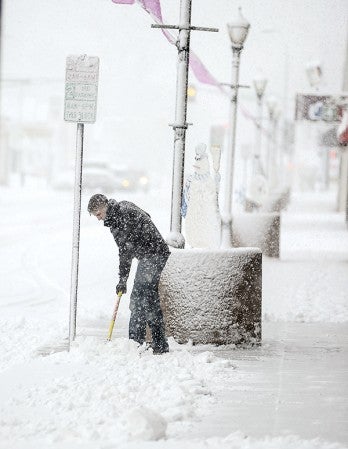Yeah, it’s that bad
Published 5:00 pm Sunday, March 2, 2014

Rydjor Bike manager Chad Burma scoops snow from the walk in front of the business as heavy snow falls on the area from this latest storm rolling through southeast Minnesota Thursday. Herald file photo
The complaints that this winter is one of the worst on record are looking pretty justified.
In fact, it’s the second coldest — at least so far.
As of Friday, the average temperature for this winter was 8.8 degrees, second only to the 7.9 degrees recorded up to the same point in the winter of 1978-79, according to the National Weather Service in La Crosse, Wis.
And don’t take the shorts and swimsuits out of storage yet, as the weather is showing few signs of improvement.
“It’s not looking good anytime soon,” said Tom Stangeland, a hydro meteorological technician with the weather service.
Since Dec. 1, Austin has had a record 54 days at or below zero, topping the previous record of 48 in 1955-56.
Need more proof that this winter has been harsh? As of Friday, the weather service had issued 24 wind chill advisories and three wind chill warnings this winter. In the entire winter of 2012-13, the weather service issued only six wind chill advisories and no warnings. The weather service only issued one wind chill advisory and no warnings in the winter of 2011-12.
The area could see another few wind chill advisories and Austin could hit 55 — if not 56 — days at or below zero over the weekend. Saturday’s high was forecasted at minus 2 and Sunday’s was minus 4, and temperatures could drop to 18 below Sunday night.
After a chilly start to the week with a high of 6 Monday, conditions will warm up a bit to the 20s later in the week and into the following week. That’s still below average, as Stangeland said average temperatures are in the 30s.
Most of this winter’s cold conditions have been caused by a persistent airflow pattern out of the northwest, which has brought cold air from the north, according to Stangeland. The best example was the much-discussed polar vortex. Stangeland said that same trend has been responsible for the drought conditions and warm weather in California.
In 2014, Austin’s average temperature has been 6.3 degrees — 6.1 in January and 6.5 in February, according to National Weather Service readings at the Austin Waste Water Treatment Facility. In 2013, the average temperature was 14.3 in January and 19.7 in February. March of 2013 didn’t produce a substantial warmup, as the average temperature was 23.8.
The first few months of 2014 have been below averages from the last 20 years. From 1981 to 2010, the average temperature in Austin was 14.6 in January and 19.5 in February.
On the bright side, February saw temperatures surpass 35 degrees for the first time since December. Temperatures topped out at 41 degrees on Feb. 19 and 20, but temperatures bottomed out at 21 below on Feb. 11 and 12.
At the Austin Waste Water Treatment Facility, the weather service has tracked 35.4 inches of snow this winter, not including snow on Friday and Saturday. Austin received 1.4 in November, 10 in December, 10.7 in January and 13.3 in February.
We could still have a lot of winter left. Last winter, Austin had 46.3 inches of snow, with 22.9 inches coming in March, April and May.

